NURSING: Interprofessional Collaboration and Patient Safety
VerifiedAdded on 2022/12/03
|8
|1842
|145
Essay
AI Summary
This essay persuasively argues the importance of interprofessional collaboration (IC) in nursing practice to ensure safe, effective, and high-quality patient care. It highlights that in complex healthcare environments, nurses rely on the expertise of multidisciplinary teams to achieve optimal patient outcomes. The essay uses examples from general settings, ICUs, and emergency departments to demonstrate how IC improves clinical rounds, patient decision-making, and reduces medical errors. The importance of communication tools and safety checklists is also emphasized, enabling nurses to fulfill their roles and meet expected care standards, ultimately contributing to enhanced patient outcomes and medical safety. The essay references research highlighting the benefits and challenges of IC, advocating for better preparation and training for nurses in collaborative practices.
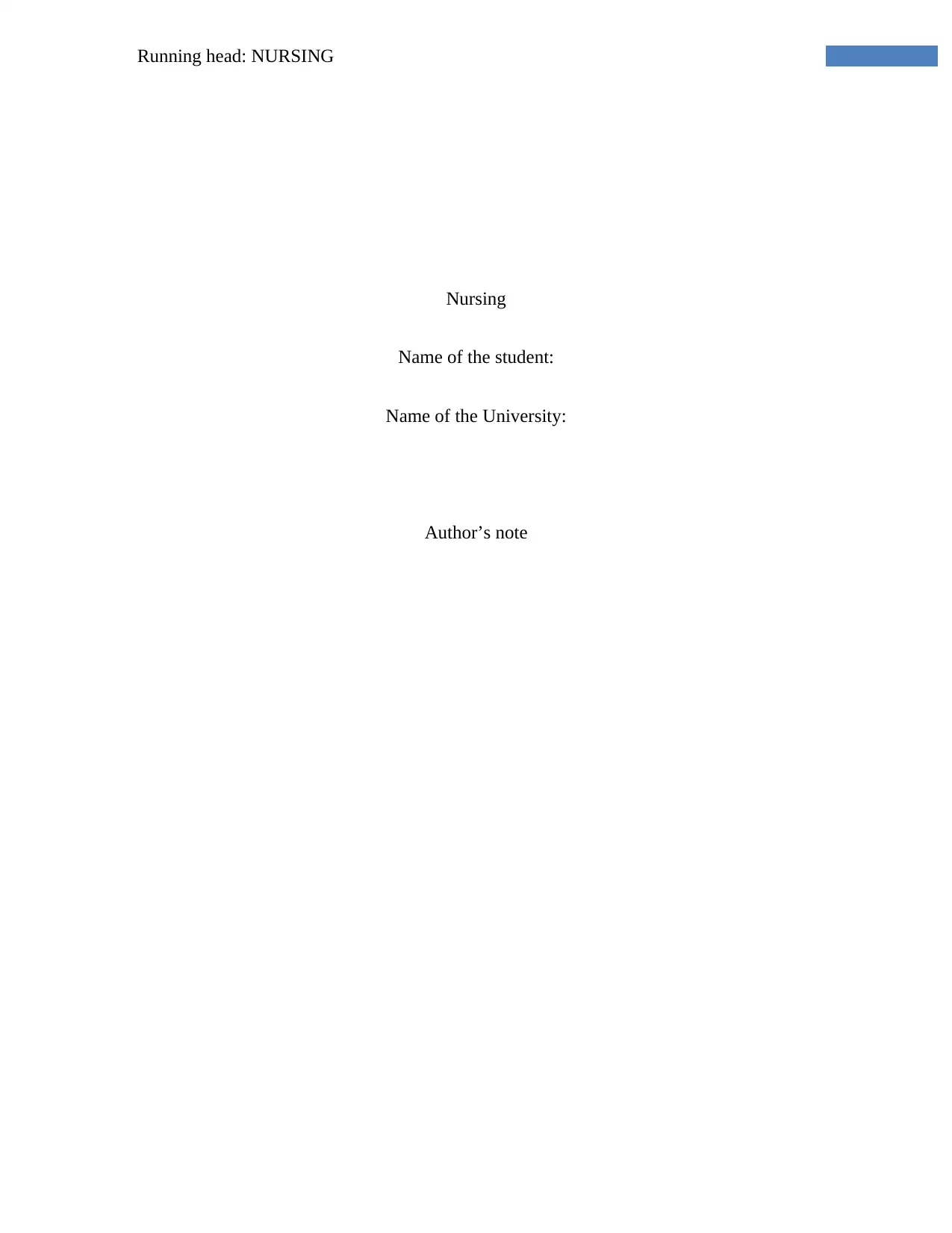
Running head: NURSING
Nursing
Name of the student:
Name of the University:
Author’s note
Nursing
Name of the student:
Name of the University:
Author’s note
Paraphrase This Document
Need a fresh take? Get an instant paraphrase of this document with our AI Paraphraser
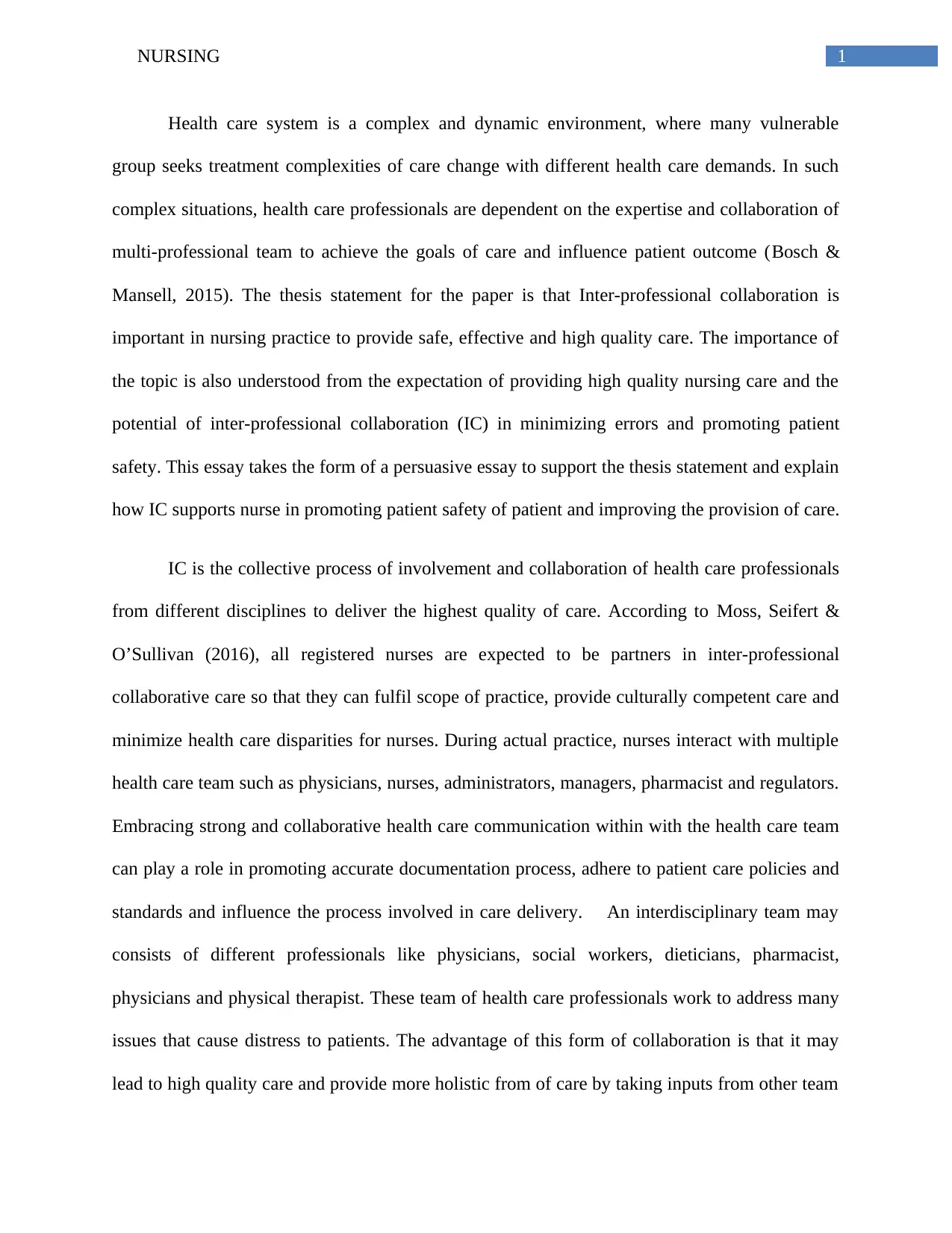
1NURSING
Health care system is a complex and dynamic environment, where many vulnerable
group seeks treatment complexities of care change with different health care demands. In such
complex situations, health care professionals are dependent on the expertise and collaboration of
multi-professional team to achieve the goals of care and influence patient outcome (Bosch &
Mansell, 2015). The thesis statement for the paper is that Inter-professional collaboration is
important in nursing practice to provide safe, effective and high quality care. The importance of
the topic is also understood from the expectation of providing high quality nursing care and the
potential of inter-professional collaboration (IC) in minimizing errors and promoting patient
safety. This essay takes the form of a persuasive essay to support the thesis statement and explain
how IC supports nurse in promoting patient safety of patient and improving the provision of care.
IC is the collective process of involvement and collaboration of health care professionals
from different disciplines to deliver the highest quality of care. According to Moss, Seifert &
O’Sullivan (2016), all registered nurses are expected to be partners in inter-professional
collaborative care so that they can fulfil scope of practice, provide culturally competent care and
minimize health care disparities for nurses. During actual practice, nurses interact with multiple
health care team such as physicians, nurses, administrators, managers, pharmacist and regulators.
Embracing strong and collaborative health care communication within with the health care team
can play a role in promoting accurate documentation process, adhere to patient care policies and
standards and influence the process involved in care delivery. An interdisciplinary team may
consists of different professionals like physicians, social workers, dieticians, pharmacist,
physicians and physical therapist. These team of health care professionals work to address many
issues that cause distress to patients. The advantage of this form of collaboration is that it may
lead to high quality care and provide more holistic from of care by taking inputs from other team
Health care system is a complex and dynamic environment, where many vulnerable
group seeks treatment complexities of care change with different health care demands. In such
complex situations, health care professionals are dependent on the expertise and collaboration of
multi-professional team to achieve the goals of care and influence patient outcome (Bosch &
Mansell, 2015). The thesis statement for the paper is that Inter-professional collaboration is
important in nursing practice to provide safe, effective and high quality care. The importance of
the topic is also understood from the expectation of providing high quality nursing care and the
potential of inter-professional collaboration (IC) in minimizing errors and promoting patient
safety. This essay takes the form of a persuasive essay to support the thesis statement and explain
how IC supports nurse in promoting patient safety of patient and improving the provision of care.
IC is the collective process of involvement and collaboration of health care professionals
from different disciplines to deliver the highest quality of care. According to Moss, Seifert &
O’Sullivan (2016), all registered nurses are expected to be partners in inter-professional
collaborative care so that they can fulfil scope of practice, provide culturally competent care and
minimize health care disparities for nurses. During actual practice, nurses interact with multiple
health care team such as physicians, nurses, administrators, managers, pharmacist and regulators.
Embracing strong and collaborative health care communication within with the health care team
can play a role in promoting accurate documentation process, adhere to patient care policies and
standards and influence the process involved in care delivery. An interdisciplinary team may
consists of different professionals like physicians, social workers, dieticians, pharmacist,
physicians and physical therapist. These team of health care professionals work to address many
issues that cause distress to patients. The advantage of this form of collaboration is that it may
lead to high quality care and provide more holistic from of care by taking inputs from other team
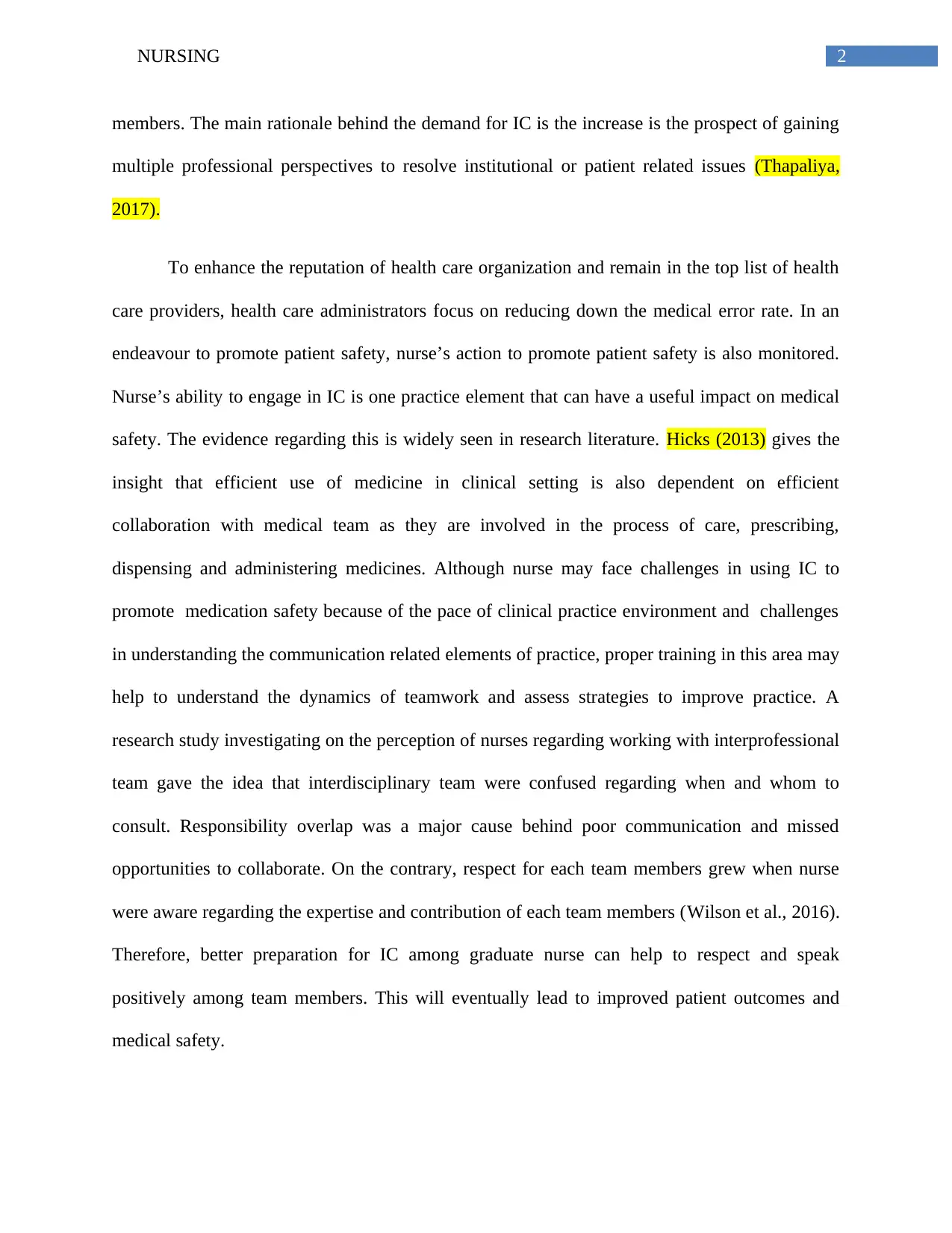
2NURSING
members. The main rationale behind the demand for IC is the increase is the prospect of gaining
multiple professional perspectives to resolve institutional or patient related issues (Thapaliya,
2017).
To enhance the reputation of health care organization and remain in the top list of health
care providers, health care administrators focus on reducing down the medical error rate. In an
endeavour to promote patient safety, nurse’s action to promote patient safety is also monitored.
Nurse’s ability to engage in IC is one practice element that can have a useful impact on medical
safety. The evidence regarding this is widely seen in research literature. Hicks (2013) gives the
insight that efficient use of medicine in clinical setting is also dependent on efficient
collaboration with medical team as they are involved in the process of care, prescribing,
dispensing and administering medicines. Although nurse may face challenges in using IC to
promote medication safety because of the pace of clinical practice environment and challenges
in understanding the communication related elements of practice, proper training in this area may
help to understand the dynamics of teamwork and assess strategies to improve practice. A
research study investigating on the perception of nurses regarding working with interprofessional
team gave the idea that interdisciplinary team were confused regarding when and whom to
consult. Responsibility overlap was a major cause behind poor communication and missed
opportunities to collaborate. On the contrary, respect for each team members grew when nurse
were aware regarding the expertise and contribution of each team members (Wilson et al., 2016).
Therefore, better preparation for IC among graduate nurse can help to respect and speak
positively among team members. This will eventually lead to improved patient outcomes and
medical safety.
members. The main rationale behind the demand for IC is the increase is the prospect of gaining
multiple professional perspectives to resolve institutional or patient related issues (Thapaliya,
2017).
To enhance the reputation of health care organization and remain in the top list of health
care providers, health care administrators focus on reducing down the medical error rate. In an
endeavour to promote patient safety, nurse’s action to promote patient safety is also monitored.
Nurse’s ability to engage in IC is one practice element that can have a useful impact on medical
safety. The evidence regarding this is widely seen in research literature. Hicks (2013) gives the
insight that efficient use of medicine in clinical setting is also dependent on efficient
collaboration with medical team as they are involved in the process of care, prescribing,
dispensing and administering medicines. Although nurse may face challenges in using IC to
promote medication safety because of the pace of clinical practice environment and challenges
in understanding the communication related elements of practice, proper training in this area may
help to understand the dynamics of teamwork and assess strategies to improve practice. A
research study investigating on the perception of nurses regarding working with interprofessional
team gave the idea that interdisciplinary team were confused regarding when and whom to
consult. Responsibility overlap was a major cause behind poor communication and missed
opportunities to collaborate. On the contrary, respect for each team members grew when nurse
were aware regarding the expertise and contribution of each team members (Wilson et al., 2016).
Therefore, better preparation for IC among graduate nurse can help to respect and speak
positively among team members. This will eventually lead to improved patient outcomes and
medical safety.
⊘ This is a preview!⊘
Do you want full access?
Subscribe today to unlock all pages.

Trusted by 1+ million students worldwide

3NURSING
Intensive care unit is a complex care environment where nurses need to be extra cautious
and attentive to ensure that any clinical deterioration in patient is managed on time. Effective IC
is also expected in ICU to improve service standards, reduce errors and contribute to service
modernization. A multi-site ethnography study has revealed the advantage of IC in ICU setting.
ICU is a busy environment where diverse group of people enter or leave. Some the current
limitations found in this setting is that doctors and nurses work separately and the nature of
interaction is very serendipitous in nature (Reeves et al., 2018). However, active communication
takes place only during emergency situations like during emergency resuscitation and end of life
discussions with patient’s family members. In view of this drawback, it is important for nurses to
adapt IC and teamwork in the ICU as it would open the pathway towards quality improvement
initiative and fulfilling diverse needs of patients and families in the ICU. Some examples of
quality improvement initiatives that has been implemented in ICU includes early exercise and
family bundle implementation, interprofessional rounding practices, end of life care, awakening
and breathing coordination and many more (Donovan et al., 2018). For the success of all these
initiatives, use of interprofessional approach is paramount for nurses.
Another rationale behind supporting IC among nurses is that can support nurses to
improve communication and collaboration during rounds. The significance of a clinical round for
multiprofessional health care team is that it makes all team members aware about patient’s
clinical progress and make collaborative plan to address the needs of the patient. The benefits of
IC during clinical rounds is understood from the fact the study by Verhaegh et al. (2017) which
revealed that communication and collaboration is associated with quick and appropriate
collection of all patient information and delivery of care. To ensure that patient safety is
promoted, it is recommended that new nurses graduating today learn about using different safety
Intensive care unit is a complex care environment where nurses need to be extra cautious
and attentive to ensure that any clinical deterioration in patient is managed on time. Effective IC
is also expected in ICU to improve service standards, reduce errors and contribute to service
modernization. A multi-site ethnography study has revealed the advantage of IC in ICU setting.
ICU is a busy environment where diverse group of people enter or leave. Some the current
limitations found in this setting is that doctors and nurses work separately and the nature of
interaction is very serendipitous in nature (Reeves et al., 2018). However, active communication
takes place only during emergency situations like during emergency resuscitation and end of life
discussions with patient’s family members. In view of this drawback, it is important for nurses to
adapt IC and teamwork in the ICU as it would open the pathway towards quality improvement
initiative and fulfilling diverse needs of patients and families in the ICU. Some examples of
quality improvement initiatives that has been implemented in ICU includes early exercise and
family bundle implementation, interprofessional rounding practices, end of life care, awakening
and breathing coordination and many more (Donovan et al., 2018). For the success of all these
initiatives, use of interprofessional approach is paramount for nurses.
Another rationale behind supporting IC among nurses is that can support nurses to
improve communication and collaboration during rounds. The significance of a clinical round for
multiprofessional health care team is that it makes all team members aware about patient’s
clinical progress and make collaborative plan to address the needs of the patient. The benefits of
IC during clinical rounds is understood from the fact the study by Verhaegh et al. (2017) which
revealed that communication and collaboration is associated with quick and appropriate
collection of all patient information and delivery of care. To ensure that patient safety is
promoted, it is recommended that new nurses graduating today learn about using different safety
Paraphrase This Document
Need a fresh take? Get an instant paraphrase of this document with our AI Paraphraser
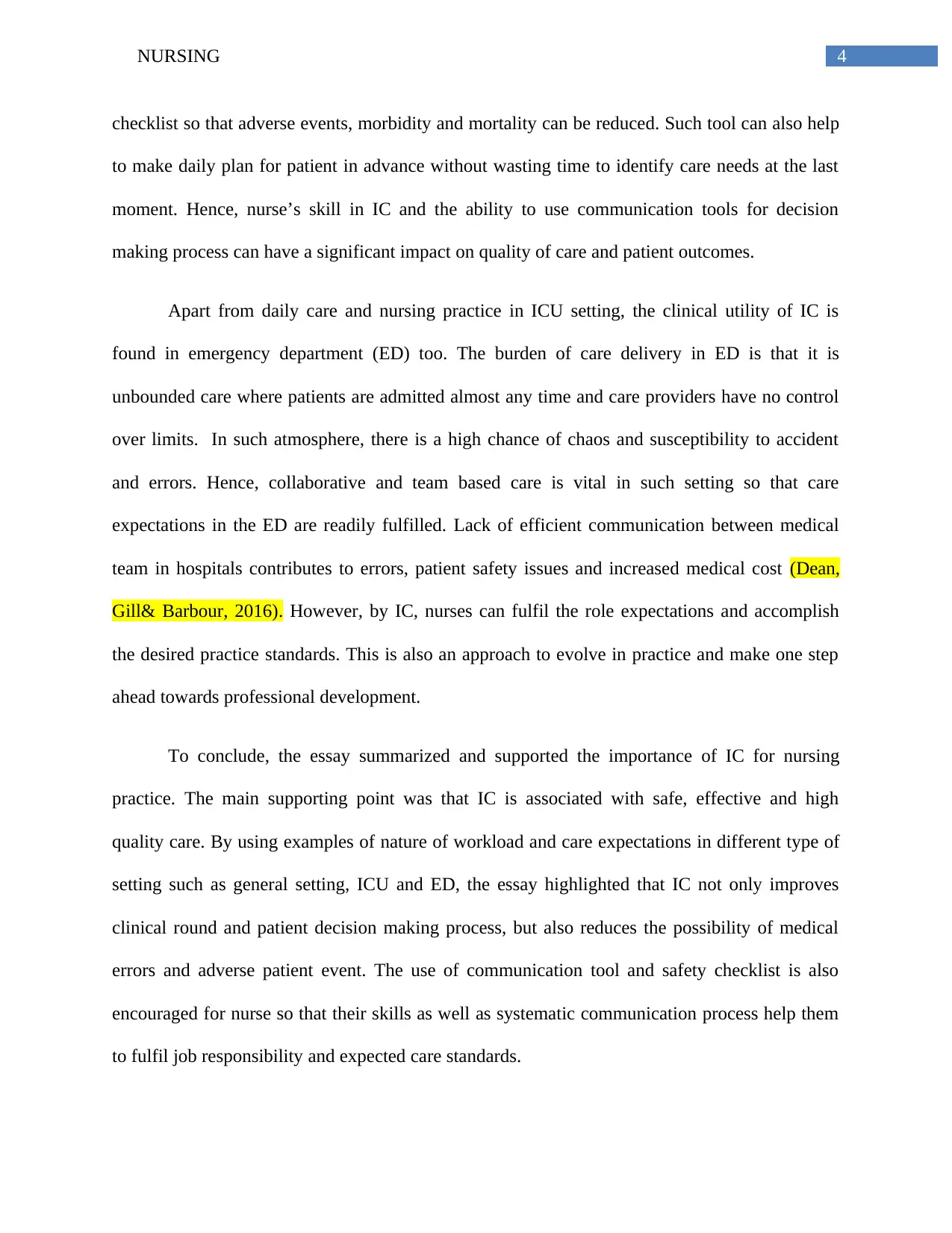
4NURSING
checklist so that adverse events, morbidity and mortality can be reduced. Such tool can also help
to make daily plan for patient in advance without wasting time to identify care needs at the last
moment. Hence, nurse’s skill in IC and the ability to use communication tools for decision
making process can have a significant impact on quality of care and patient outcomes.
Apart from daily care and nursing practice in ICU setting, the clinical utility of IC is
found in emergency department (ED) too. The burden of care delivery in ED is that it is
unbounded care where patients are admitted almost any time and care providers have no control
over limits. In such atmosphere, there is a high chance of chaos and susceptibility to accident
and errors. Hence, collaborative and team based care is vital in such setting so that care
expectations in the ED are readily fulfilled. Lack of efficient communication between medical
team in hospitals contributes to errors, patient safety issues and increased medical cost (Dean,
Gill& Barbour, 2016). However, by IC, nurses can fulfil the role expectations and accomplish
the desired practice standards. This is also an approach to evolve in practice and make one step
ahead towards professional development.
To conclude, the essay summarized and supported the importance of IC for nursing
practice. The main supporting point was that IC is associated with safe, effective and high
quality care. By using examples of nature of workload and care expectations in different type of
setting such as general setting, ICU and ED, the essay highlighted that IC not only improves
clinical round and patient decision making process, but also reduces the possibility of medical
errors and adverse patient event. The use of communication tool and safety checklist is also
encouraged for nurse so that their skills as well as systematic communication process help them
to fulfil job responsibility and expected care standards.
checklist so that adverse events, morbidity and mortality can be reduced. Such tool can also help
to make daily plan for patient in advance without wasting time to identify care needs at the last
moment. Hence, nurse’s skill in IC and the ability to use communication tools for decision
making process can have a significant impact on quality of care and patient outcomes.
Apart from daily care and nursing practice in ICU setting, the clinical utility of IC is
found in emergency department (ED) too. The burden of care delivery in ED is that it is
unbounded care where patients are admitted almost any time and care providers have no control
over limits. In such atmosphere, there is a high chance of chaos and susceptibility to accident
and errors. Hence, collaborative and team based care is vital in such setting so that care
expectations in the ED are readily fulfilled. Lack of efficient communication between medical
team in hospitals contributes to errors, patient safety issues and increased medical cost (Dean,
Gill& Barbour, 2016). However, by IC, nurses can fulfil the role expectations and accomplish
the desired practice standards. This is also an approach to evolve in practice and make one step
ahead towards professional development.
To conclude, the essay summarized and supported the importance of IC for nursing
practice. The main supporting point was that IC is associated with safe, effective and high
quality care. By using examples of nature of workload and care expectations in different type of
setting such as general setting, ICU and ED, the essay highlighted that IC not only improves
clinical round and patient decision making process, but also reduces the possibility of medical
errors and adverse patient event. The use of communication tool and safety checklist is also
encouraged for nurse so that their skills as well as systematic communication process help them
to fulfil job responsibility and expected care standards.

5NURSING
⊘ This is a preview!⊘
Do you want full access?
Subscribe today to unlock all pages.

Trusted by 1+ million students worldwide

6NURSING
References:
Hicks, D. (2015). Can rounding reduce patient falls in acute care? An integrative literature
review. Medsurg nursing, 24(1), 51.
Bosch, B., & Mansell, H. (2015). Interprofessional collaboration in health care: Lessons to be
learned from competitive sports. Canadian Pharmacists Journal/Revue des Pharmaciens
du Canada, 148(4), 176-179.
Dean, M., Gill, R., & Barbour, J. B. (2016). “Let’s sit forward”: Investigating interprofessional
communication, collaboration, professional roles, and physical space at
EmergiCare. Health communication, 31(12), 1506-1516.
Donovan, A. L., Aldrich, J. M., Gross, A. K., Barchas, D. M., Thornton, K. C., Schell-Chaple, H.
M., ... & Schwarz, J. (2018). Interprofessional Care and Teamwork in the ICU. Critical
care medicine, 46(6), 980-990.
Moss, E., Seifert, P. C., & O’Sullivan, A. (2016). Registered nurses as interprofessional
collaborative partners: Creating value-based outcomes. OJIN: The Online Journal of
Issues in Nursing, 21(3).
Reeves, S., McMillan, S. E., Kachan, N., Paradis, E., Leslie, M., & Kitto, S. (2015).
Interprofessional collaboration and family member involvement in intensive care units:
emerging themes from a multi-sited ethnography. Journal of Interprofessional
Care, 29(3), 230-237.
Thapaliya, R. (2017). How Teamwork Makes the Dream Work. TheWorldPost.(accessed June
15, 2017).
References:
Hicks, D. (2015). Can rounding reduce patient falls in acute care? An integrative literature
review. Medsurg nursing, 24(1), 51.
Bosch, B., & Mansell, H. (2015). Interprofessional collaboration in health care: Lessons to be
learned from competitive sports. Canadian Pharmacists Journal/Revue des Pharmaciens
du Canada, 148(4), 176-179.
Dean, M., Gill, R., & Barbour, J. B. (2016). “Let’s sit forward”: Investigating interprofessional
communication, collaboration, professional roles, and physical space at
EmergiCare. Health communication, 31(12), 1506-1516.
Donovan, A. L., Aldrich, J. M., Gross, A. K., Barchas, D. M., Thornton, K. C., Schell-Chaple, H.
M., ... & Schwarz, J. (2018). Interprofessional Care and Teamwork in the ICU. Critical
care medicine, 46(6), 980-990.
Moss, E., Seifert, P. C., & O’Sullivan, A. (2016). Registered nurses as interprofessional
collaborative partners: Creating value-based outcomes. OJIN: The Online Journal of
Issues in Nursing, 21(3).
Reeves, S., McMillan, S. E., Kachan, N., Paradis, E., Leslie, M., & Kitto, S. (2015).
Interprofessional collaboration and family member involvement in intensive care units:
emerging themes from a multi-sited ethnography. Journal of Interprofessional
Care, 29(3), 230-237.
Thapaliya, R. (2017). How Teamwork Makes the Dream Work. TheWorldPost.(accessed June
15, 2017).
Paraphrase This Document
Need a fresh take? Get an instant paraphrase of this document with our AI Paraphraser
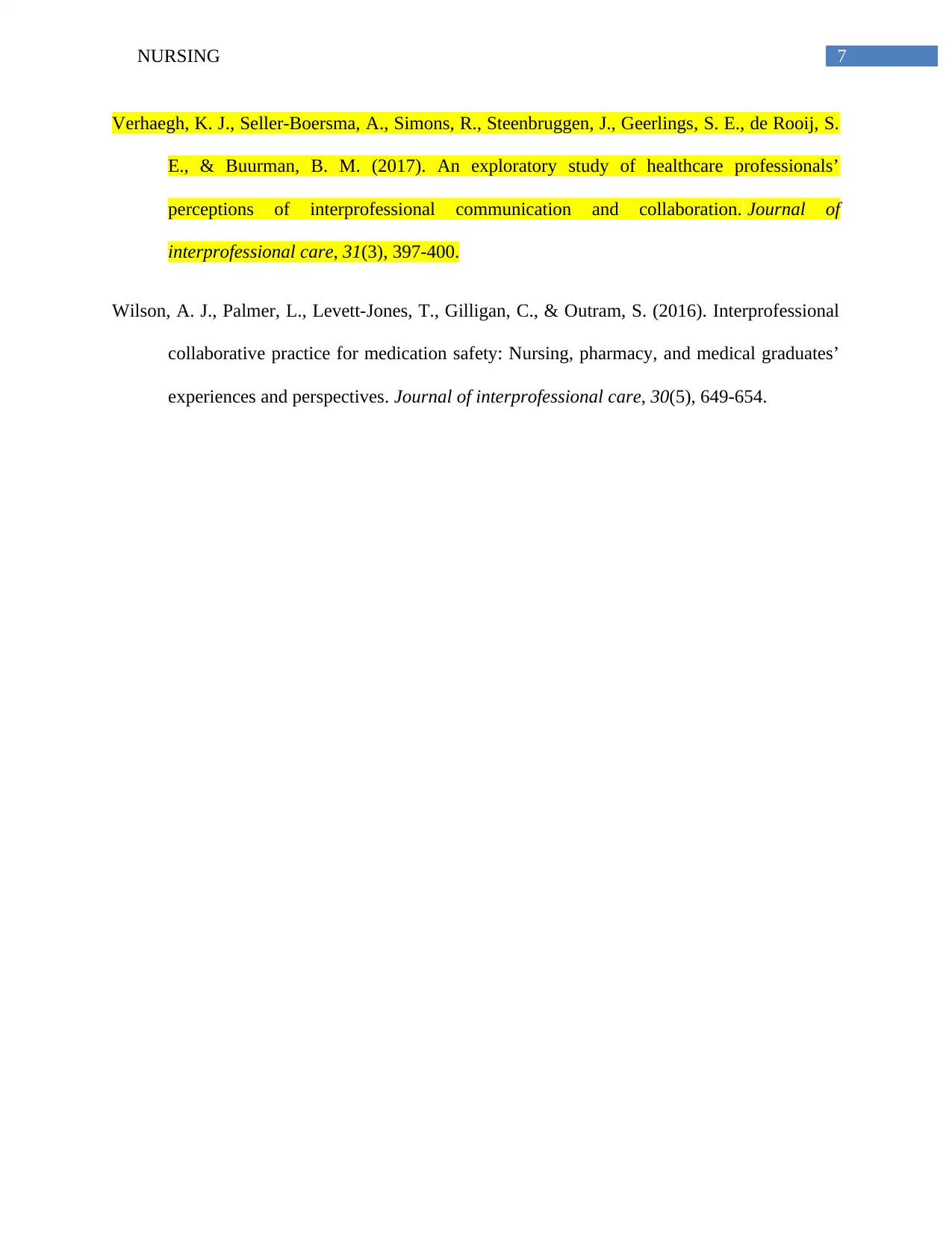
7NURSING
Verhaegh, K. J., Seller-Boersma, A., Simons, R., Steenbruggen, J., Geerlings, S. E., de Rooij, S.
E., & Buurman, B. M. (2017). An exploratory study of healthcare professionals’
perceptions of interprofessional communication and collaboration. Journal of
interprofessional care, 31(3), 397-400.
Wilson, A. J., Palmer, L., Levett-Jones, T., Gilligan, C., & Outram, S. (2016). Interprofessional
collaborative practice for medication safety: Nursing, pharmacy, and medical graduates’
experiences and perspectives. Journal of interprofessional care, 30(5), 649-654.
Verhaegh, K. J., Seller-Boersma, A., Simons, R., Steenbruggen, J., Geerlings, S. E., de Rooij, S.
E., & Buurman, B. M. (2017). An exploratory study of healthcare professionals’
perceptions of interprofessional communication and collaboration. Journal of
interprofessional care, 31(3), 397-400.
Wilson, A. J., Palmer, L., Levett-Jones, T., Gilligan, C., & Outram, S. (2016). Interprofessional
collaborative practice for medication safety: Nursing, pharmacy, and medical graduates’
experiences and perspectives. Journal of interprofessional care, 30(5), 649-654.
1 out of 8
Related Documents
Your All-in-One AI-Powered Toolkit for Academic Success.
+13062052269
info@desklib.com
Available 24*7 on WhatsApp / Email
![[object Object]](/_next/static/media/star-bottom.7253800d.svg)
Unlock your academic potential
Copyright © 2020–2025 A2Z Services. All Rights Reserved. Developed and managed by ZUCOL.





